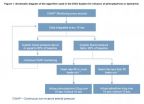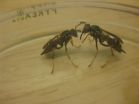(Press-News.org) Curtin University researchers have found a way to breed disease-resistant wheat with no downside, potentially bringing multi-million dollar savings to Australia's agricultural industry.
According to John Curtin Distinguished Professor Richard Oliver, Director of the Australian Centre for Necrotrophic Fungal Pathogens (ACNFP) at Curtin, farmers can lose more than 0.35 tonnes per hectare in wheat yields to Yellow Spot, even after applying fungicide.
For an average-sized farm of 4000 hectares, this could mean an almost $500,000 loss to disease per year – or about $212 million worth of damage to the wider Australian agricultural industry.
Funded by the Grains Research & Development Corporation, Professor Oliver and his team, in conjunction with independent research provider Kalyx Australia, have demonstrated that by taking away disease-sensitivity genes from the wheat germplasm, pathogens find it difficult to latch onto wheat and cause damage.
"Our finding will help breeders produce crops in which disease losses are 60 to 80 per cent lower, and would be a real win for farmers – they will often be able to avoid using foliar fungicides," Professor Oliver said.
"Before now, breeding for resistance to Yellow (Tan) Spot and Septoria Nodorum Blotch was very time-consuming – no molecular markers were in use. The key has been to supply breeders with specific proteins (we call them effectors) that the fungi use to cause disease.
"For the first time, our technology allows for a steady and sustained improvement in disease resistance without affecting the farmer's pocket.
"Furthermore, breeders are able to devote more time and resources to breeding for yield, as well as for rust and frost resistance."
Using large wheat variety trials provided by Kalyx Australia, the team looked at yield loss of different cultivars (plants chosen for breeding because of desirable characteristics) when subjected to natural disease and stress pressures in the WA wheatbelt.
They compared cultivars with disease-sensitivity genes to cultivars that lacked these particular genes, and were able to show that the cultivars lacking the gene showed no yield loss and in some instances increased yields in the presence of disease.
From this, the team were able to conclude if a sensitivity gene was eliminated, there would be minimal associated risks and it would be a safe and straightforward strategy for improving disease resistance.
Professor Oliver said this research had never been done before as direct mapping for disease resistance had not led to useful molecular markers.
"Previously geneticists would infect plants that were progeny of crosses between relatively resistant and relatively susceptible parents before doing the QTL (quantitative disease-resistance gene) mapping. But as disease resistance is multifactorial due to the several effector reactions, the QTL mapping was always a bit fuzzy and was therefore never passed on," Professor Oliver said.
"Our research looks directly at the loci that recognise the pathogens, which can be readily identified using a process we developed earlier, thereby bypassing the need for QTL mapping."
INFORMATION:
The paper, Absence of detectable yield penalty associated with insensitivity to Pleosporales necrotrophic effectors in wheat grown in the West Australian wheat belt, can be found at http://onlinelibrary.wiley.com/doi/10.1111/ppa.12191/abstract
Genetic discovery to keep crops disease-free
New breeding technology could save farmers millions
2014-02-10
ELSE PRESS RELEASES FROM THIS DATE:
Slowing down the immune system when in overdrive
2014-02-10
Many people suffer from chronic inflammation because their immune systems overreact to 'self' tissue. Sydney scientists believe that a small molecule known as Interleukin 21 is a promising therapeutic target in such cases.
Interleukin 21 (IL-21) is one of a group of chemical messengers known as 'cytokines', which affect the behaviour of immune cells. IL-21 is already well known to play an important role in autoimmune diseases such as Sjögren's syndrome and type 1 diabetes.
The current study shows how much IL-21 contributes to inflammation. It also shows how important ...
When you always gotta go…
2014-02-10
Problems related to urination, including incontinence and having to get up to urinate at night-time, have become more acceptable topics of discussion over recent years. New treatment options have also led doctors to address these symptoms more actively. Despite this, no study has effectively compared the bother of each of these bladder symptoms for men and women of all ages.
The FINNO Study is an ongoing questionnaire survey conducted right across Finland. A random sample of 6,000 adults identified from the Finnish Population Register, were contacted with a questionnaire ...
New trial results affirm better blood pressure management during C-section
2014-02-10
10 February 2014, Singapore: New trial results1 have shown that the world's first Double
Intravenous Vasopressor Automated (DIVA) System affords superior control of maternal blood pressure in women undergoing caesarean section under spinal anaesthesia, when compared with manually-administered medication to manage reduced blood pressure (vasopressor).
Developed by doctors at KK Women's and Children's Hospital (KKH), the novel DIVA System detects and responds rapidly to low blood pressure and/or slow heart rate in real time by auto-administering a precise amount of the ...
Normal enzyme aids a mutant 1 to fuel blood cancer's growth
2014-02-10
BOSTON (Feb. 10, 2014)—Reinforcing the need to look beyond genomic alterations to understand the complexity of cancer, researchers from Dana-Farber/Boston Children's Cancer and Blood Disorders Center report that a normal enzyme called SYK pairs with FLT3, the most commonly mutated enzyme found in acute myelogenous leukemia (AML), to promote progression of the disease. This molecular partnership also promotes AML cells' resistance to treatment with FLT3-blocking drugs, potentially explaining the relatively poor showing of FLT3 inhibitors in multiple clinical studies. In ...
Flat-pack lens boosts solar power
2014-02-10
Micro-machining could be used to create almost flat, Fresnel lenses, that boost the electrical efficiency of solar panels, according to researchers in China.
Fresnel lenses were invented by French engineer and scientist Augustin-Jean Fresnel, in the early nineteenth century, they are essential two-dimensional equivalents of conventional optical lens, but they have ridges in concentric rings that focus the light to a point behind the lens without the three-dimensional bulk of a conventional lens. Image quality is reduced when using a Fresnel lens to focus because the concentric ...
Study reveals unexpected cell hijack method in pancreatic cancer
2014-02-10
Pancreatic stellate cells, which normally aid tissue repair, unwittingly help pancreatic cancer grow and spread in a method of 'cell hijack' only seen before in brain and breast cancer, according to new research from Queen Mary University of London.
The research, published in the latest issue of EMBO Molecular Medicine and carried out by Queen Mary's Barts Cancer Institute, also revealed the process can be blocked, thereby preventing the growth and spread of the tumour.
The study, funded by the UK charity Pancreatic Cancer Research Fund, set out to investigate the messaging ...
EORTC characterizes responders & survivors on pazopanib for advanced soft tissue sarcoma
2014-02-10
An EORTC analysis appearing in Annals of Oncology confirmed the importance of known prognostic factors such as performance status and tumor grading for having a long-term outcome in patients treated with pazopanib for metastatic soft tissue sarcoma. Additionally, hemoglobin at baseline was found to be a new prognostic factor.
Soft tissue sarcomas are a heterogeneous and relatively rare tumor with an estimated incidence of four per 100,000 people per year in Europe. The prognosis for patients with this disease is favorable if they are diagnosed at an early stage and if ...
Massive neutrinos solve a cosmological conundrum
2014-02-10
Scientists have solved a major problem with the current standard model of cosmology identified by combining results from the Planck spacecraft and measurements of gravitational lensing in order to deduce the mass of ghostly sub-atomic particles called neutrinos.
The team, from the universities of Manchester and Nottingham, used observations of the Big Bang and the curvature of space-time to accurately measure the mass of these elementary particles for the first time.
The recent Planck spacecraft observations of the Cosmic Microwave Background (CMB) – the fading glow ...
Wasps use ancient aggression genes to create social groups
2014-02-10
Aggression-causing genes appeared early in animal evolution and have maintained their roles for millions of years and across many species, even though animal aggression today varies widely from territorial fighting to setting up social hierarchies, according to researchers from Iowa State University, Penn State and Grand Valley State University.
If these "mean genes" keep their roles in different animals and in different contexts, then perhaps model organisms -- such as bees and mice -- can provide insights into the biological basis of aggression in all animals, including ...
Dental care in school breaks down social inequalities
2014-02-10
A new survey conducted by the University of Copenhagen and the World Health Organization (WHO) is highlighting the role of schools in work to promote health and prevent disease.
"Children in Scandinavia generally have healthy teeth and gums, largely on account of dental care in schools for all children, the arrival of fluoride toothpaste on the market, a healthy lifestyle and high living standards. But the situation in the poorest countries of the world is very different to that in Scandinavia. However, it is positive to note that the WHO's Health Promoting Schools Initiative ...
LAST 30 PRESS RELEASES:
Making lighter work of calculating fluid and heat flow
Normalizing blood sugar can halve heart attack risk
Lowering blood sugar cuts heart attack risk in people with prediabetes
Study links genetic variants to risk of blinding eye disease in premature infants
Non-opioid ‘pain sponge’ therapy halts cartilage degeneration and relieves chronic pain
AI can pick up cultural values by mimicking how kids learn
China’s ecological redlines offer fast track to 30 x 30 global conservation goal
Invisible indoor threats: emerging household contaminants and their growing risks to human health
Adding antibody treatment to chemo boosts outcomes for children with rare cancer
Germline pathogenic variants among women without a history of breast cancer
Tanning beds triple melanoma risk, potentially causing broad DNA damage
Unique bond identified as key to viral infection speed
Indoor tanning makes youthful skin much older on a genetic level
Mouse model sheds new light on the causes and potential solutions to human GI problems linked to muscular dystrophy
The Journal of Nuclear Medicine ahead-of-print tip sheet: December 12, 2025
Smarter tools for peering into the microscopic world
Applications open for funding to conduct research in the Kinsey Institute archives
Global measure underestimates the severity of food insecurity
Child survivors of critical illness are missing out on timely follow up care
Risk-based vs annual breast cancer screening / the WISDOM randomized clinical trial
University of Toronto launches Electric Vehicle Innovation Ontario to accelerate advanced EV technologies and build Canada’s innovation advantage
Early relapse predicts poor outcomes in aggressive blood cancer
American College of Lifestyle Medicine applauds two CMS models aligned with lifestyle medicine practice and reimbursement
Clinical trial finds cannabis use not a barrier to quitting nicotine vaping
Supplemental nutrition assistance program policies and food insecurity
Switching immune cells to “night mode” could limit damage after a heart attack, study suggests
URI-based Global RIghts Project report spotlights continued troubling trends in worldwide inhumane treatment
Neutrophils are less aggressive at night, explaining why nighttime heart attacks cause less damage than daytime events
Menopausal hormone therapy may not pose breast cancer risk for women with BRCA mutations
Mobile health tool may improve quality of life for adolescent and young adult breast cancer survivors
[Press-News.org] Genetic discovery to keep crops disease-freeNew breeding technology could save farmers millions


